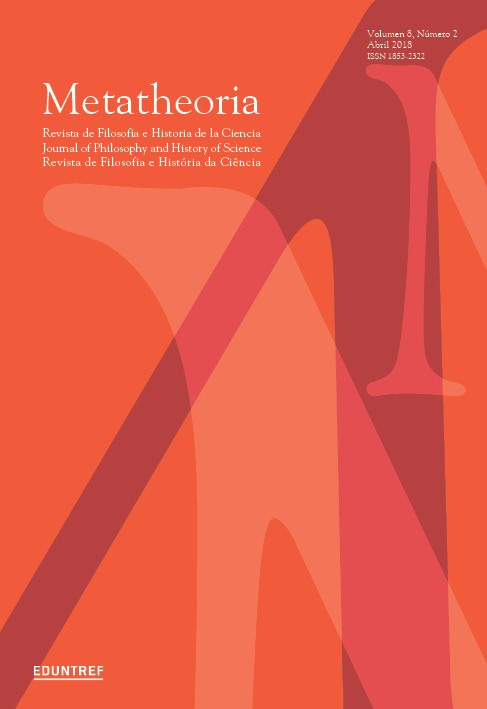Natural Selection and Massive Modularity
DOI:
https://doi.org/10.48160/18532330me8.173Keywords:
cognitive modularity, natural selection, time construal, intuitive mathematicsAbstract
Massive modularity, the theory of human architecture according to which during the evolution of cognition natural selection mainly produced massive-type modules, is denied. After depicting massive modularity of cognition, I recall some of its critics. Then, I consider two cases of cognitive capabilities: a very basic one, time construal, and a complex one, mathematization. I show how these skills cannot be explained on the grounds of massive modularity. As I will show, we have strong reasons to discourage the pursuit of evolutionary accounts for all and every cognitive capacity we currently accomplish, thus contradicting massive modularity central assumption.
References
Ávila del Palacio, A.(2016), “¿Es innata laidea de la recta numérica?”, en Hernández, P., García, J. y M.Romo (eds.), Cognición: Estudios Multidisciplinarios, México: CEFPSVLT, pp.19-30.
Carruthers, P. (2005), Consciousness: Essays from a Higher-Order Perspective, Oxford: Oxford University Press.
Carruthers, P.(2006), The Architecture of the Mind: Massive Modularity and the Flexibility of Thought, Oxford: Clarendon Press.
Chomsky, N.(1986), Knowledge of Language: Its Nature, Origin, and Use, Westport: Praeger.
Cosmides, L. y J. Tooby (1992), “Cognitive Adaptations for Social Exchange”, en Barkow, J., Cosmides, L. y J.Tooby (eds.), The Adapted Mind: Evolutionary Psychology and the Generation of Culture, New York: Oxford University Press, pp.163-228.
Cosmides, L. y J. Tooby (1994), “Beyond Intuition and Instinct Blindness: Towards an Evolutionary Rigorous Cognitive Science”, Cognition 50: 41-77.
Cosmides, L. y J.Tooby (1997),“Evolutionary Psychology: A Primer”. Accesible en: http://www.psych.ucsb.edu/research/cep/primer.html.
Cosmides, L. y J. Tooby (1998), “Evolutionizing the Cognitive Sciences: A Reply to Shapiro and Epstein”, Mind and Language13: 195-204.
Dawkins, R. (1986), The Blind Watchmaker, London-New York: Longmans-Norton.
Dehaene, S., Bossini, S. y P. Giraux (1993), “The Mental Representation of Parity and Number Magnitude”, Journal of Experimental Psychology: General122: 371-396.
Dehaene, S. y L. Cohen (1995), “Towards an Anatomical and Functional Model of Number Processing”, Mathematical Cognition 1:83-120.
Dehaene, S., Izard, V., Spelke, E. y P. Pica (2008),“Log or Linear? Distinct Intuitions of the Number Scale in Western and Amazonian Indigene Cultures”, Science320:1217-1220.
Fodor, J.(1983), The Modularity of Mind. An Essay on Faculty Psychology, Cambridge:MIT Press.
Fodor, J.(1998), In Critical Condition: Polemical Essays on Cognitive Science and the Philosophy of Mind, Cambridge: MIT Press.
Fodor, J.(2000), The Mind Doesn't Work That Way: The Scope and Limits of Computational Psychology, Cambridge: MIT Press.
García, C.L. (2004), “Especificidad de dominio y sesgo en la psicología del razonamiento humano”, Signos Filosóficos6(12): 63-91.
García, C.L. (2007),“Cognitive Modularity, Biological Modularity, and Evolvability”, Biological Theory: Integrating Development, Evolution and Cognition2(1): 62-73.
Gould, S.J. y R.C. Lewontin (1979), “The Spandrels of San Marco and the Panglossian Paradigm: A Critique of the Adaptationist Programme”, Proceedings of the Royal Society of LondonB 205: 581-598.
Núñez, R., Cooperrider, K. y J. Wassmann (2012), “Numbers Concepts without Number Lines in an Indigenous Group of Papua New Ginea”, Plos One7(4): e35662.
Núñez, R. y K. Cooperrider (2013),“The Tangle of Space and Time in Human Cognition”, Trends in Cognitive Sciences17(5): 220-229.
Penn, D.C., Holiyoak, K.J. yD.J. Povinelli (2008), “Darwin’s Mistake: Explaining the Discontinuity Between Human and Nonhuman Minds”, Behavioral and Brain Sciences 31:109-178.
Pinker, S. (1997), How the Mind Works, Harmondsworth: Penguin.
Plotkin, H.C. (1997), Evolution in Mind: An Introduction to Evolutionary Psychology, Harmondsworth: Penguin.
Shapiro, L. y W. Epstein (1998), “Evolutionary Theory Meets Cognitive Psychology: AMore Selective Perspective”, Mind and Language13: 171-194.
Simon, H. A. (1962), “The Architecture of Complexity”, Proceedings of the American Philosophical Society106: 467-482.
Sperber, D. (1994), “The Modularity of Thought and the Epidemiology of Representations”, en Hirschfeld, L.A. y S.A. Gelman (eds.), Mapping the Mind: Domain Specificity in Cognition and Culture, New York: Cambridge University Press, pp. 39-67.
Sperber, D. (1996), Explaining Culture: A Naturalistic Approach, Oxford: Blackwell.
Sperber, D. (2002), “In Defense of Masive Modularity”, en Dupoux, E.(ed.), Language, Brain and Cognitive Development: Essays in Honor of Jacques Mehler, Cambridge: MIT Press, pp. 47-57.
Srinivasan, M. y S. Carey (2010), “The Long and the Short of It: On the Nature and Origin of Functional Overlap Between Representations of Space and Time”, Cognition116: 217-241.
Starr, A., Libertus, M.E. y E.M. Brannon (2013),“Number Sense in Infancy Predicts Mathematical Abilities in Childhood”, Proceedings of the National Academy of Sciences110(45):18116-18120.
Xu, F. y E.S. Spelke(2000), “Large Number Discrimination in 6-Month-Old Infants”, Cognition74(1): B1-B11.
Downloads
Published
How to Cite
Issue
Section
License
Copyright (c) 2018 Metatheoria – Journal of Philosophy and History of ScienceThe documents published here are governed by the licensing criteria
Creative Commons Argentina.Atribución - No Comercial - Sin Obra Derivada 2.5 https://creativecommons.org/licenses/by-nc-nd/2.5/ar/





